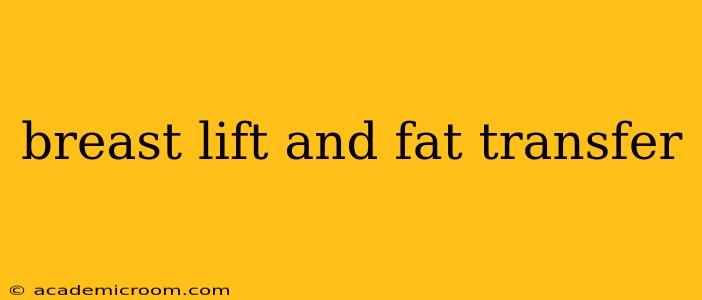A breast lift, or mastopexy, and fat transfer are two distinct procedures that can be used individually or in combination to enhance breast appearance. This comprehensive guide explores both techniques, detailing their benefits, risks, and suitability for different individuals. We'll delve into the specifics of each procedure, addressing common questions and concerns.
What is a Breast Lift?
A breast lift is a surgical procedure designed to improve the shape and position of the breasts. It addresses sagging breasts by removing excess skin and repositioning the nipple and areola. This results in a higher, firmer, and more youthful breast appearance. The procedure can be tailored to individual needs, with different techniques used depending on the degree of sagging and the patient's desired outcome. Different incision patterns are used depending on the amount of breast tissue lift needed.
What is a Fat Transfer for Breasts?
A fat transfer, also known as autologous fat grafting, involves harvesting fat from one area of the body (typically the abdomen, thighs, or hips) and transferring it to the breasts. This technique can augment breast size, improve breast shape, and restore volume lost due to aging or weight fluctuations. The fat is carefully processed before injection, increasing the likelihood of successful graft survival. This is a less invasive approach than traditional breast augmentation using silicone implants.
What are the Benefits of Combining a Breast Lift and Fat Transfer?
Combining a breast lift and fat transfer offers several advantages over undergoing either procedure alone:
- Natural-looking results: Fat transfer creates a softer, more natural-looking breast augmentation compared to implants. When combined with a lift, the overall result is more aesthetically pleasing and proportionate to the body.
- Improved breast shape and volume: The lift addresses sagging, while the fat transfer adds volume, resulting in a more youthful and well-proportioned breast shape.
- Reduced scarring: In some cases, combining the procedures might allow for smaller incisions compared to a lift alone.
- Less invasive than implants: Eliminates the need for foreign body implants, reducing potential risks and complications associated with them.
What are the Risks and Potential Complications?
While generally safe, both procedures carry potential risks and complications, including:
- Infection: As with any surgery, there's a risk of infection at the incision sites or within the grafted fat.
- Hematoma (blood clot): A collection of blood can form under the skin, requiring drainage.
- Seroma (fluid collection): Similar to hematoma, a collection of fluid may require drainage.
- Fat necrosis (fat death): Some transferred fat cells may not survive, leading to irregularities in breast shape. This is less common with advanced fat grafting techniques.
- Asymmetry: It is challenging to achieve perfect symmetry, and some degree of asymmetry may remain.
- Unsatisfactory aesthetic outcome: The result may not fully meet the patient's expectations.
- Nerve damage: Rare, but possible.
What is the recovery process like?
Recovery time varies depending on the extent of the procedure and individual healing rates. Patients can generally expect some discomfort, bruising, and swelling in the initial days post-operation. A support bra is usually necessary for several weeks. Returning to normal activities gradually over several weeks is common. Full recovery may take several months. Detailed instructions and follow-up appointments with the surgeon are essential.
Is a breast lift and fat transfer right for me?
The suitability of a combined breast lift and fat transfer depends on various factors, including the amount of breast sagging, the desired outcome, and the patient's overall health. A consultation with a qualified plastic surgeon is crucial to determine if this combined procedure is the right option. The surgeon will assess your individual needs and expectations and discuss the potential risks and benefits.
How much does a breast lift with fat transfer cost?
The cost varies significantly depending on the surgeon's fees, location, and the complexity of the procedure. It's essential to discuss the pricing with your surgeon during the consultation.
What are the alternatives to a breast lift with fat transfer?
Alternatives include a breast lift alone, breast augmentation with implants, or no treatment at all. The best approach depends on individual circumstances and preferences.
How long do the results of a breast lift and fat transfer last?
The results of a breast lift are generally long-lasting. However, aging and weight fluctuations can eventually lead to some degree of sagging. The longevity of fat transfer depends on fat survival rate and is also influenced by these factors.
This information is intended for educational purposes only and should not be considered medical advice. Always consult with a qualified plastic surgeon to discuss your specific circumstances and determine the best course of treatment for you.
